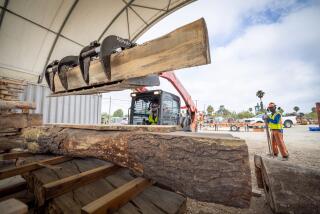COLUMN LEFT/ ALEXANDER COCKBURN : Owls vs. Kids on T-Shirts? Don’t Buy It : The timber companies lied about over-cutting. Why believe them about job losses?
- Share via
Once again the spotted owl stands accused of threatening workers’ livelihoods--indeed, the well-being of the timber economy of the whole Pacific Northwest.
Last week, the federal Fish and Wildlife Service designated 6.9 million acres of forest as critical to the owl’s survival, noting that at current rates of harvest, the remaining old growth will have disappeared in 15 to 30 years.
Already the timber industry and its allies have fastened on the jobs issue. The Fish and Wildlife Service predicted that preservation of spotted owl habitat would cost about 33,000 jobs. The industry is already throwing around numbers like 80,000. Soon loggers will be sporting company-supplied T-shirts with owl-versus-hungry-kids logos; the right-wing talk shows will be abuzz with the owl recipe du jour.
The campaign is a fraud, and the internal corporate memos are there to prove it. These memos, which have been circulating in the environmental community for two or three months, surfaced publicly in the Jan. 5 edition of the Santa Rosa Press Democrat in an article by that newspaper’s timber correspondent, Mike Geniella.
The memos, written by a 16-year senior employee of Louisiana Pacific, one of the timber giants of the Northwest, and by an L-P consultant who was formerly director of the California Department of Forestry, show that responsible people inside the industry have been saying exactly the same things as environmentalists.
On March 19, 1990, just as the Redwood Summer campaign was warming up, with Louisiana Pacific’s flacks denouncing Earth First activists as ignorant trouble-makers, Bob Morris, resource chief for the company’s western division, was writing to L-P chief Harry Merlo: “It now appears we are currently harvesting at a rate nearly double our sustained yield (i.e. growth volume).” Morris described this as a resource philosophy akin to “liquidation.”
At the end of 1990, on Dec. 18, Jerry Partain, a former state forestry department director regarded as an industry advocate, summed up a consulting assignment for L-P in a private memo to Joe Wheeler, the company’s western division manager: “It is now clear to me that the environmental activists, the Department of Forestry, your contract loggers and your foresters are all correct when they say your present harvest rate cannot be continued for long and that the company must either reduce that rate significantly now or make deep and drastic cuts just a few years from now” (an assessment in which the state forestry board recently and publicly concurred).
Partain stated that L-P’s logging of small-diameter trees was creating a large hole in its timber inventory “that cannot be recovered for decades.” By last August, not long before Morris was fired (he’s now back with the company), he wrote bitterly to Merlo: “The management of L-P owes its stockholders, long-time employees, their families and the dependent communities a better legacy than is now unfolding.”
These smoking-gun memos put the spotted owl frenzy in perspective. Corporate timber is desperate to get full access to publicly owned forests because it has recklessly degraded its private resource.
As specious as the industry’s pretensions to responsible resource management is the notion that the owl’s future must be balanced against 33,000 jobs. Employment in the timber industry along the North Coast has dropped for decades, long before the owl became an issue. The Fish and Wildlife Service said many of the jobs would soon disappear, owl or no owl. L-P’s western division work force dropped from 2,700 in 1988 to 1,700 today because of mill closures and its export of unfinished redwood logs to its new plant in Mexico.
The spotted owl is an “indicator species,” meaning its impending extinction signals a much wider threat in terms of loss of habitat, biodiversity and the maintenance of commercially important gene pools of plants and trees. A threat to the owl is a threat to much else, including the tourist economy of the Northwest. Who, except real estate developers, wants to stroll through clear-cut old growth?
The destruction of old growth is already very far advanced, with the big timber corporations left undisturbed in their rampages for decades. The best thing would be for the government to declare eminent domain and give the huge private timber empires to the local loggers and have them harvest the timber responsibly on a sustained yield basis. Better them than the moguls of lumber, issuing orders to pillage from their corporate headquarters in Atlanta (Georgia Pacific), Portland, Ore., (Louisiana Pacific) and Houston (Maxxam, owner of Pacific Lumber).
More to Read
Inside the business of entertainment
The Wide Shot brings you news, analysis and insights on everything from streaming wars to production — and what it all means for the future.
You may occasionally receive promotional content from the Los Angeles Times.










